Analysis of Long-Term Performance in Pedestrian Concrete Timber Bridge
VerifiedAdded on 2020/03/16
|18
|4776
|142
Report
AI Summary
This journal paper comprehensively examines the long-term performance of pedestrian concrete timber bridges. It begins with an introduction to the historical use of timber and the evolution to timber-concrete composite (TCC) structures, highlighting their ecological benefits and cost-effectiveness. The paper reviews existing literature on TCC bridge structures, focusing on material properties, long-term behavior, and the effects of environmental conditions such as moisture and temperature. The methodology includes interviews and observations within the construction industry, ministry of transport, and among pedestrians. Research questions address the nature of TCC structures, long-term performance of beams and entire bridges, environmental impacts, and the feasibility of TCC as a sustainable alternative. The study aims to identify key factors influencing the durability and lifespan of these bridges, including the impact of cyclic moisture and load-bearing capacities. The paper also discusses data collection methods, experimental setups, and presents results, discussions, and conclusions to provide recommendations for improved design and performance of TCC bridges. The paper emphasizes the importance of considering long-term performance in the design phase to ensure the structure's longevity and sustainability.
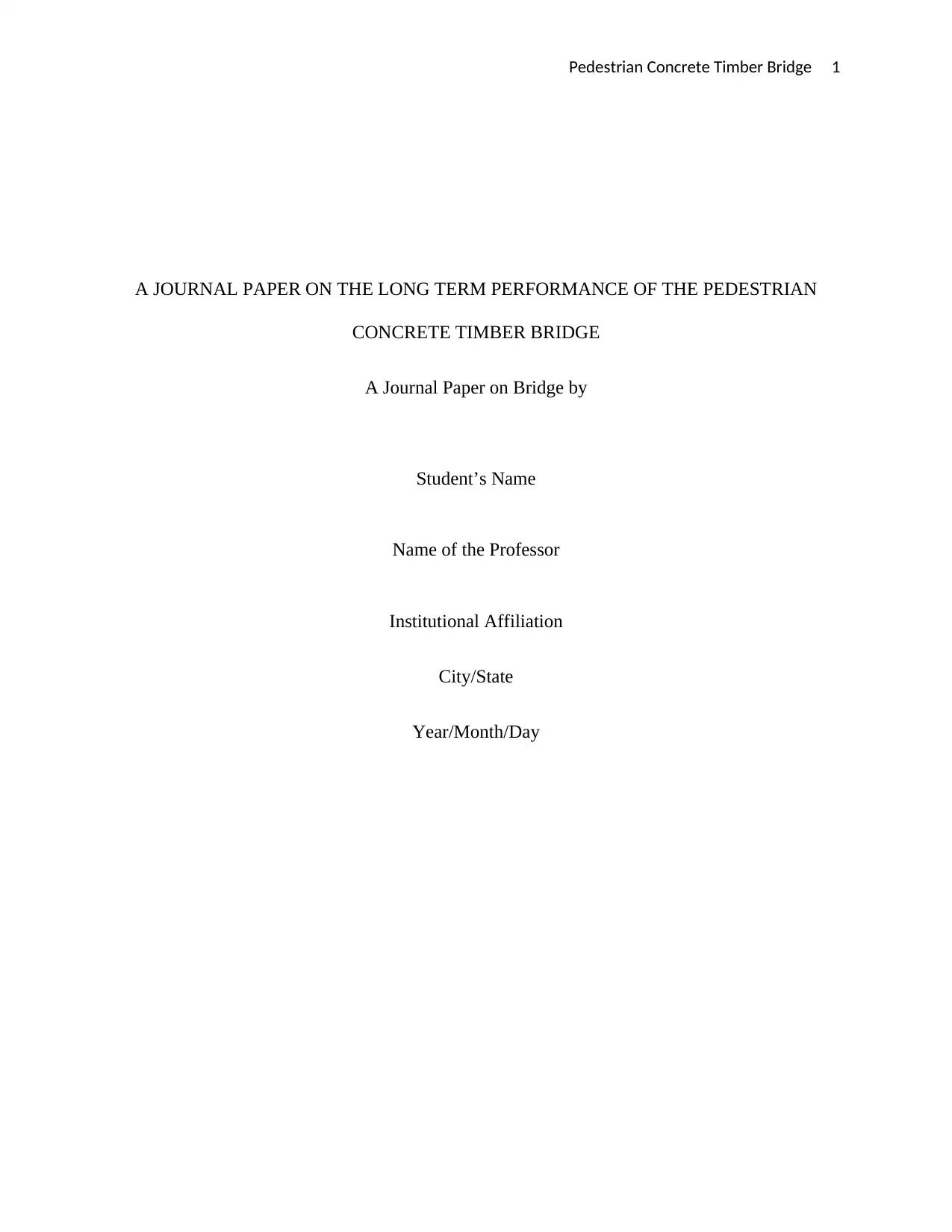
Pedestrian Concrete Timber Bridge 1
A JOURNAL PAPER ON THE LONG TERM PERFORMANCE OF THE PEDESTRIAN
CONCRETE TIMBER BRIDGE
A Journal Paper on Bridge by
Student’s Name
Name of the Professor
Institutional Affiliation
City/State
Year/Month/Day
A JOURNAL PAPER ON THE LONG TERM PERFORMANCE OF THE PEDESTRIAN
CONCRETE TIMBER BRIDGE
A Journal Paper on Bridge by
Student’s Name
Name of the Professor
Institutional Affiliation
City/State
Year/Month/Day
Paraphrase This Document
Need a fresh take? Get an instant paraphrase of this document with our AI Paraphraser
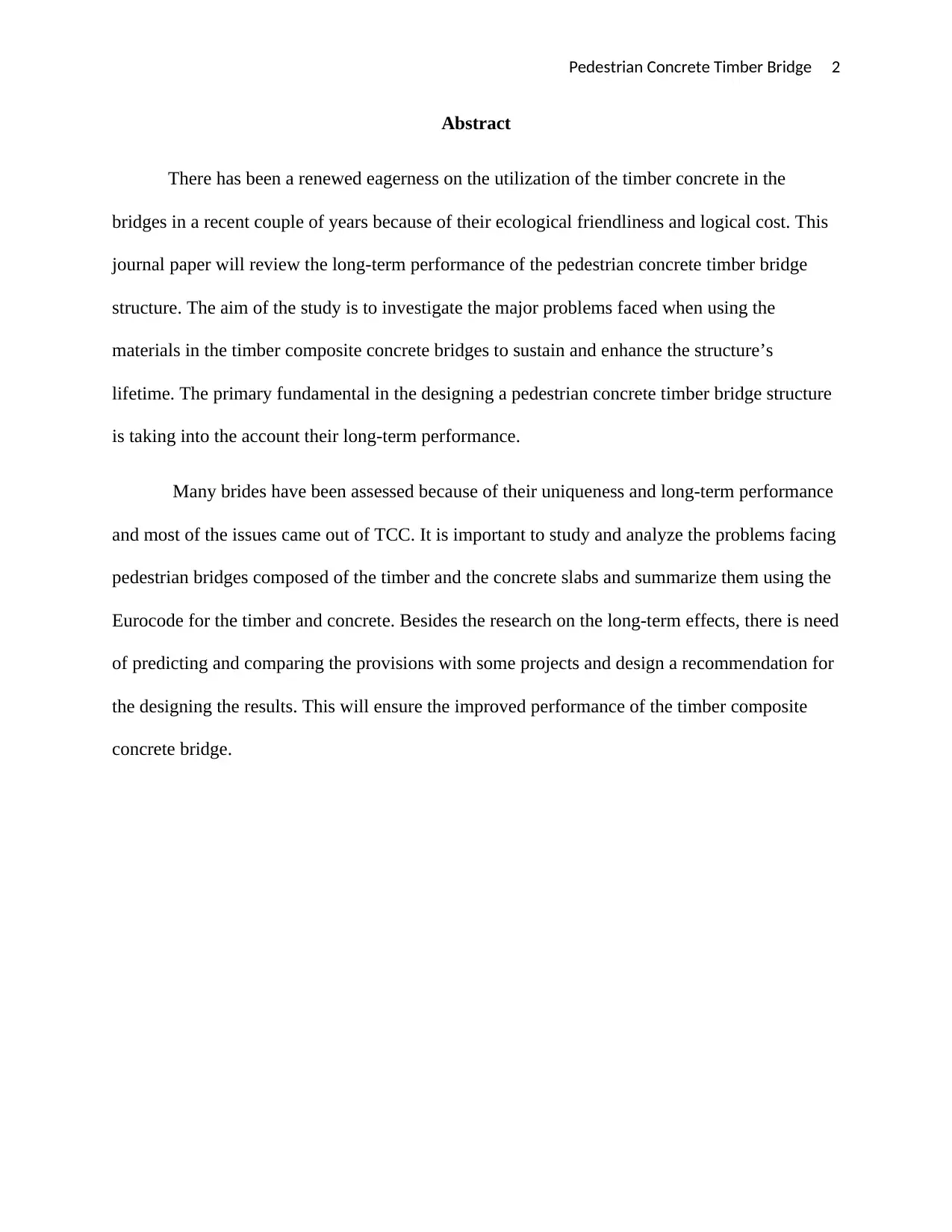
Pedestrian Concrete Timber Bridge 2
Abstract
There has been a renewed eagerness on the utilization of the timber concrete in the
bridges in a recent couple of years because of their ecological friendliness and logical cost. This
journal paper will review the long-term performance of the pedestrian concrete timber bridge
structure. The aim of the study is to investigate the major problems faced when using the
materials in the timber composite concrete bridges to sustain and enhance the structure’s
lifetime. The primary fundamental in the designing a pedestrian concrete timber bridge structure
is taking into the account their long-term performance.
Many brides have been assessed because of their uniqueness and long-term performance
and most of the issues came out of TCC. It is important to study and analyze the problems facing
pedestrian bridges composed of the timber and the concrete slabs and summarize them using the
Eurocode for the timber and concrete. Besides the research on the long-term effects, there is need
of predicting and comparing the provisions with some projects and design a recommendation for
the designing the results. This will ensure the improved performance of the timber composite
concrete bridge.
Abstract
There has been a renewed eagerness on the utilization of the timber concrete in the
bridges in a recent couple of years because of their ecological friendliness and logical cost. This
journal paper will review the long-term performance of the pedestrian concrete timber bridge
structure. The aim of the study is to investigate the major problems faced when using the
materials in the timber composite concrete bridges to sustain and enhance the structure’s
lifetime. The primary fundamental in the designing a pedestrian concrete timber bridge structure
is taking into the account their long-term performance.
Many brides have been assessed because of their uniqueness and long-term performance
and most of the issues came out of TCC. It is important to study and analyze the problems facing
pedestrian bridges composed of the timber and the concrete slabs and summarize them using the
Eurocode for the timber and concrete. Besides the research on the long-term effects, there is need
of predicting and comparing the provisions with some projects and design a recommendation for
the designing the results. This will ensure the improved performance of the timber composite
concrete bridge.
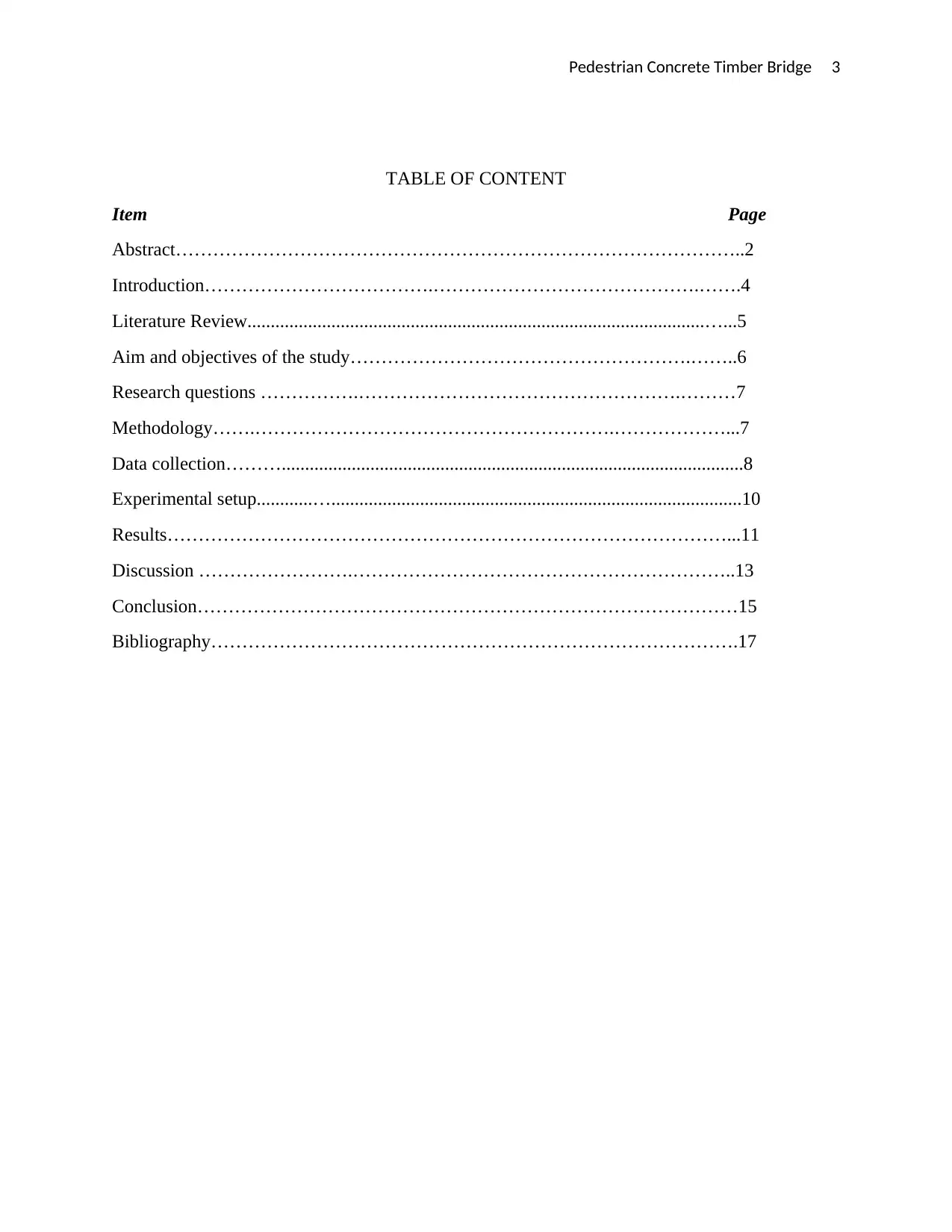
Pedestrian Concrete Timber Bridge 3
TABLE OF CONTENT
Item Page
Abstract………………………………………………………………………………..2
Introduction……………………………….…………………………………….…….4
Literature Review..................................................................................................…...5
Aim and objectives of the study……………………………………………….……..6
Research questions …………….…………………………………………….………7
Methodology…….………………………………………………….………………...7
Data collection………...................................................................................................8
Experimental setup............…........................................................................................10
Results………………………………………………………………………………...11
Discussion …………………….……………………………………………………..13
Conclusion……………………………………………………………………………15
Bibliography………………………………………………………………………….17
TABLE OF CONTENT
Item Page
Abstract………………………………………………………………………………..2
Introduction……………………………….…………………………………….…….4
Literature Review..................................................................................................…...5
Aim and objectives of the study……………………………………………….……..6
Research questions …………….…………………………………………….………7
Methodology…….………………………………………………….………………...7
Data collection………...................................................................................................8
Experimental setup............…........................................................................................10
Results………………………………………………………………………………...11
Discussion …………………….……………………………………………………..13
Conclusion……………………………………………………………………………15
Bibliography………………………………………………………………………….17
⊘ This is a preview!⊘
Do you want full access?
Subscribe today to unlock all pages.

Trusted by 1+ million students worldwide
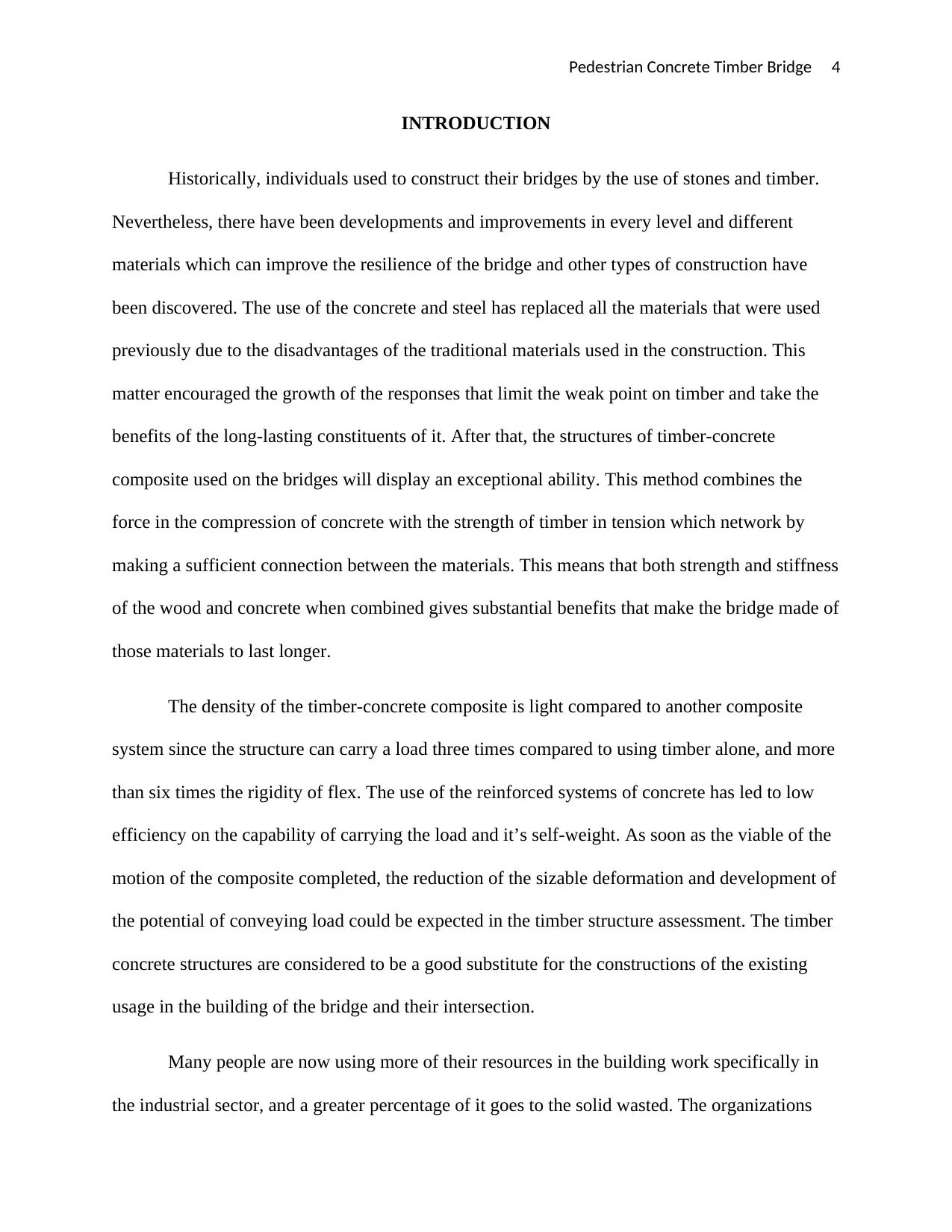
Pedestrian Concrete Timber Bridge 4
INTRODUCTION
Historically, individuals used to construct their bridges by the use of stones and timber.
Nevertheless, there have been developments and improvements in every level and different
materials which can improve the resilience of the bridge and other types of construction have
been discovered. The use of the concrete and steel has replaced all the materials that were used
previously due to the disadvantages of the traditional materials used in the construction. This
matter encouraged the growth of the responses that limit the weak point on timber and take the
benefits of the long-lasting constituents of it. After that, the structures of timber-concrete
composite used on the bridges will display an exceptional ability. This method combines the
force in the compression of concrete with the strength of timber in tension which network by
making a sufficient connection between the materials. This means that both strength and stiffness
of the wood and concrete when combined gives substantial benefits that make the bridge made of
those materials to last longer.
The density of the timber-concrete composite is light compared to another composite
system since the structure can carry a load three times compared to using timber alone, and more
than six times the rigidity of flex. The use of the reinforced systems of concrete has led to low
efficiency on the capability of carrying the load and it’s self-weight. As soon as the viable of the
motion of the composite completed, the reduction of the sizable deformation and development of
the potential of conveying load could be expected in the timber structure assessment. The timber
concrete structures are considered to be a good substitute for the constructions of the existing
usage in the building of the bridge and their intersection.
Many people are now using more of their resources in the building work specifically in
the industrial sector, and a greater percentage of it goes to the solid wasted. The organizations
INTRODUCTION
Historically, individuals used to construct their bridges by the use of stones and timber.
Nevertheless, there have been developments and improvements in every level and different
materials which can improve the resilience of the bridge and other types of construction have
been discovered. The use of the concrete and steel has replaced all the materials that were used
previously due to the disadvantages of the traditional materials used in the construction. This
matter encouraged the growth of the responses that limit the weak point on timber and take the
benefits of the long-lasting constituents of it. After that, the structures of timber-concrete
composite used on the bridges will display an exceptional ability. This method combines the
force in the compression of concrete with the strength of timber in tension which network by
making a sufficient connection between the materials. This means that both strength and stiffness
of the wood and concrete when combined gives substantial benefits that make the bridge made of
those materials to last longer.
The density of the timber-concrete composite is light compared to another composite
system since the structure can carry a load three times compared to using timber alone, and more
than six times the rigidity of flex. The use of the reinforced systems of concrete has led to low
efficiency on the capability of carrying the load and it’s self-weight. As soon as the viable of the
motion of the composite completed, the reduction of the sizable deformation and development of
the potential of conveying load could be expected in the timber structure assessment. The timber
concrete structures are considered to be a good substitute for the constructions of the existing
usage in the building of the bridge and their intersection.
Many people are now using more of their resources in the building work specifically in
the industrial sector, and a greater percentage of it goes to the solid wasted. The organizations
Paraphrase This Document
Need a fresh take? Get an instant paraphrase of this document with our AI Paraphraser
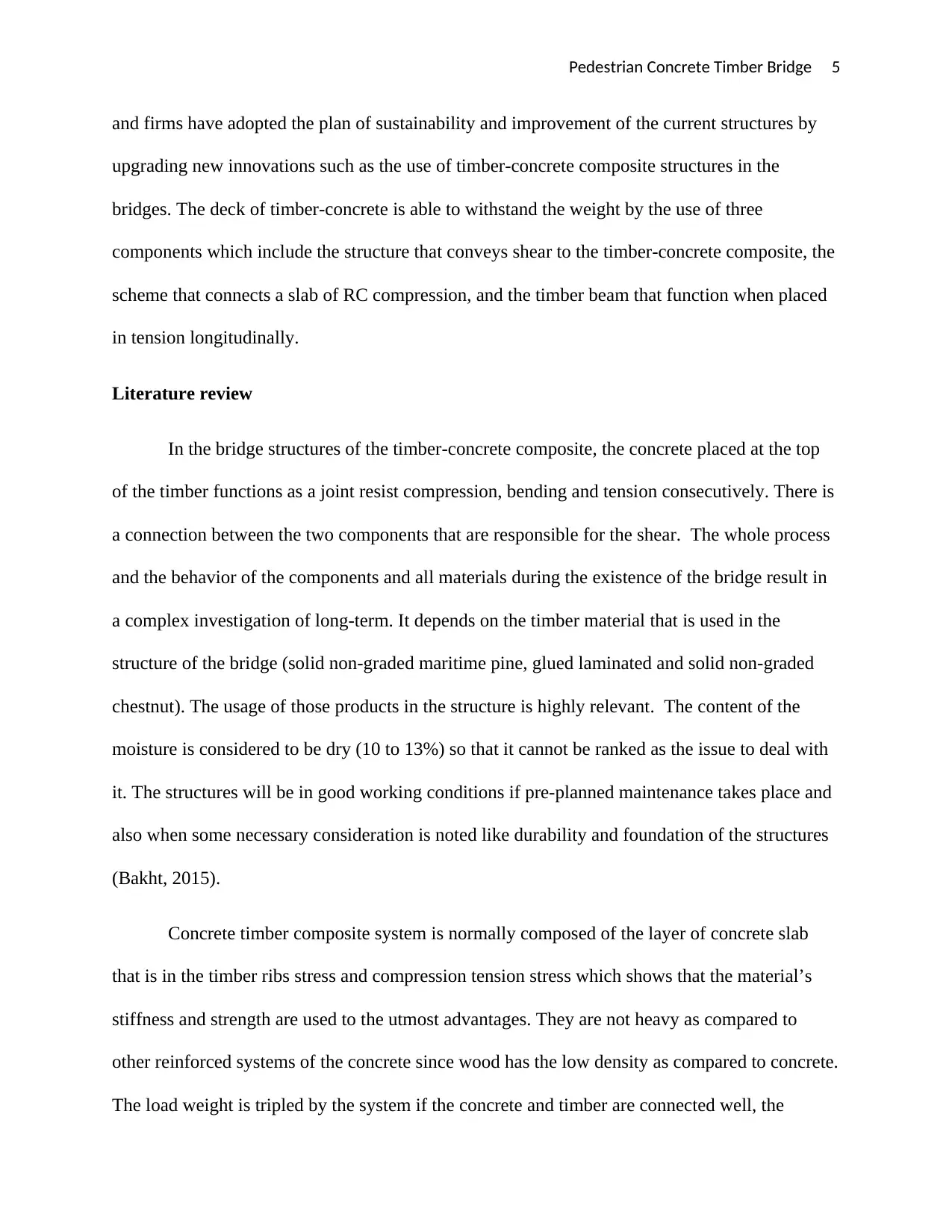
Pedestrian Concrete Timber Bridge 5
and firms have adopted the plan of sustainability and improvement of the current structures by
upgrading new innovations such as the use of timber-concrete composite structures in the
bridges. The deck of timber-concrete is able to withstand the weight by the use of three
components which include the structure that conveys shear to the timber-concrete composite, the
scheme that connects a slab of RC compression, and the timber beam that function when placed
in tension longitudinally.
Literature review
In the bridge structures of the timber-concrete composite, the concrete placed at the top
of the timber functions as a joint resist compression, bending and tension consecutively. There is
a connection between the two components that are responsible for the shear. The whole process
and the behavior of the components and all materials during the existence of the bridge result in
a complex investigation of long-term. It depends on the timber material that is used in the
structure of the bridge (solid non-graded maritime pine, glued laminated and solid non-graded
chestnut). The usage of those products in the structure is highly relevant. The content of the
moisture is considered to be dry (10 to 13%) so that it cannot be ranked as the issue to deal with
it. The structures will be in good working conditions if pre-planned maintenance takes place and
also when some necessary consideration is noted like durability and foundation of the structures
(Bakht, 2015).
Concrete timber composite system is normally composed of the layer of concrete slab
that is in the timber ribs stress and compression tension stress which shows that the material’s
stiffness and strength are used to the utmost advantages. They are not heavy as compared to
other reinforced systems of the concrete since wood has the low density as compared to concrete.
The load weight is tripled by the system if the concrete and timber are connected well, the
and firms have adopted the plan of sustainability and improvement of the current structures by
upgrading new innovations such as the use of timber-concrete composite structures in the
bridges. The deck of timber-concrete is able to withstand the weight by the use of three
components which include the structure that conveys shear to the timber-concrete composite, the
scheme that connects a slab of RC compression, and the timber beam that function when placed
in tension longitudinally.
Literature review
In the bridge structures of the timber-concrete composite, the concrete placed at the top
of the timber functions as a joint resist compression, bending and tension consecutively. There is
a connection between the two components that are responsible for the shear. The whole process
and the behavior of the components and all materials during the existence of the bridge result in
a complex investigation of long-term. It depends on the timber material that is used in the
structure of the bridge (solid non-graded maritime pine, glued laminated and solid non-graded
chestnut). The usage of those products in the structure is highly relevant. The content of the
moisture is considered to be dry (10 to 13%) so that it cannot be ranked as the issue to deal with
it. The structures will be in good working conditions if pre-planned maintenance takes place and
also when some necessary consideration is noted like durability and foundation of the structures
(Bakht, 2015).
Concrete timber composite system is normally composed of the layer of concrete slab
that is in the timber ribs stress and compression tension stress which shows that the material’s
stiffness and strength are used to the utmost advantages. They are not heavy as compared to
other reinforced systems of the concrete since wood has the low density as compared to concrete.
The load weight is tripled by the system if the concrete and timber are connected well, the
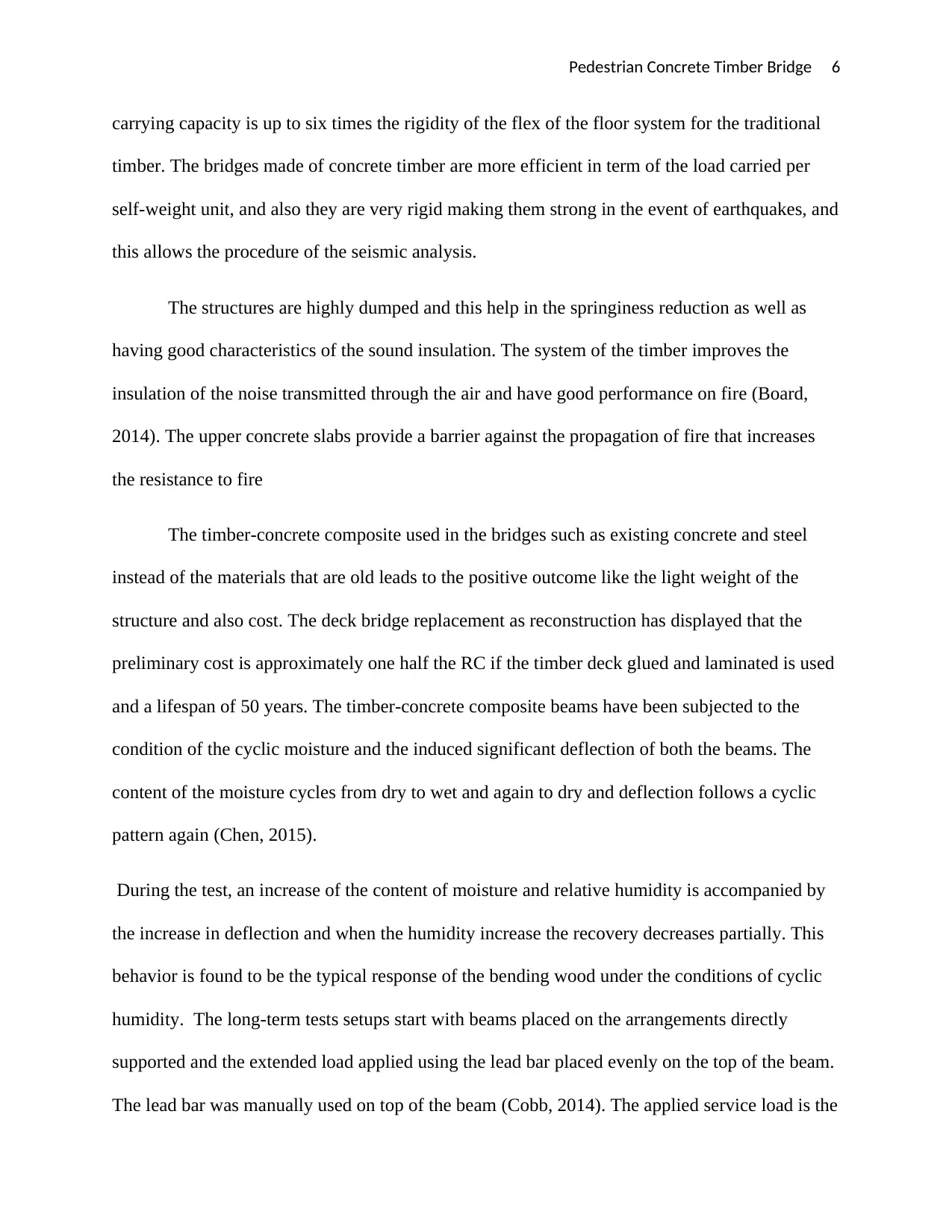
Pedestrian Concrete Timber Bridge 6
carrying capacity is up to six times the rigidity of the flex of the floor system for the traditional
timber. The bridges made of concrete timber are more efficient in term of the load carried per
self-weight unit, and also they are very rigid making them strong in the event of earthquakes, and
this allows the procedure of the seismic analysis.
The structures are highly dumped and this help in the springiness reduction as well as
having good characteristics of the sound insulation. The system of the timber improves the
insulation of the noise transmitted through the air and have good performance on fire (Board,
2014). The upper concrete slabs provide a barrier against the propagation of fire that increases
the resistance to fire
The timber-concrete composite used in the bridges such as existing concrete and steel
instead of the materials that are old leads to the positive outcome like the light weight of the
structure and also cost. The deck bridge replacement as reconstruction has displayed that the
preliminary cost is approximately one half the RC if the timber deck glued and laminated is used
and a lifespan of 50 years. The timber-concrete composite beams have been subjected to the
condition of the cyclic moisture and the induced significant deflection of both the beams. The
content of the moisture cycles from dry to wet and again to dry and deflection follows a cyclic
pattern again (Chen, 2015).
During the test, an increase of the content of moisture and relative humidity is accompanied by
the increase in deflection and when the humidity increase the recovery decreases partially. This
behavior is found to be the typical response of the bending wood under the conditions of cyclic
humidity. The long-term tests setups start with beams placed on the arrangements directly
supported and the extended load applied using the lead bar placed evenly on the top of the beam.
The lead bar was manually used on top of the beam (Cobb, 2014). The applied service load is the
carrying capacity is up to six times the rigidity of the flex of the floor system for the traditional
timber. The bridges made of concrete timber are more efficient in term of the load carried per
self-weight unit, and also they are very rigid making them strong in the event of earthquakes, and
this allows the procedure of the seismic analysis.
The structures are highly dumped and this help in the springiness reduction as well as
having good characteristics of the sound insulation. The system of the timber improves the
insulation of the noise transmitted through the air and have good performance on fire (Board,
2014). The upper concrete slabs provide a barrier against the propagation of fire that increases
the resistance to fire
The timber-concrete composite used in the bridges such as existing concrete and steel
instead of the materials that are old leads to the positive outcome like the light weight of the
structure and also cost. The deck bridge replacement as reconstruction has displayed that the
preliminary cost is approximately one half the RC if the timber deck glued and laminated is used
and a lifespan of 50 years. The timber-concrete composite beams have been subjected to the
condition of the cyclic moisture and the induced significant deflection of both the beams. The
content of the moisture cycles from dry to wet and again to dry and deflection follows a cyclic
pattern again (Chen, 2015).
During the test, an increase of the content of moisture and relative humidity is accompanied by
the increase in deflection and when the humidity increase the recovery decreases partially. This
behavior is found to be the typical response of the bending wood under the conditions of cyclic
humidity. The long-term tests setups start with beams placed on the arrangements directly
supported and the extended load applied using the lead bar placed evenly on the top of the beam.
The lead bar was manually used on top of the beam (Cobb, 2014). The applied service load is the
⊘ This is a preview!⊘
Do you want full access?
Subscribe today to unlock all pages.

Trusted by 1+ million students worldwide
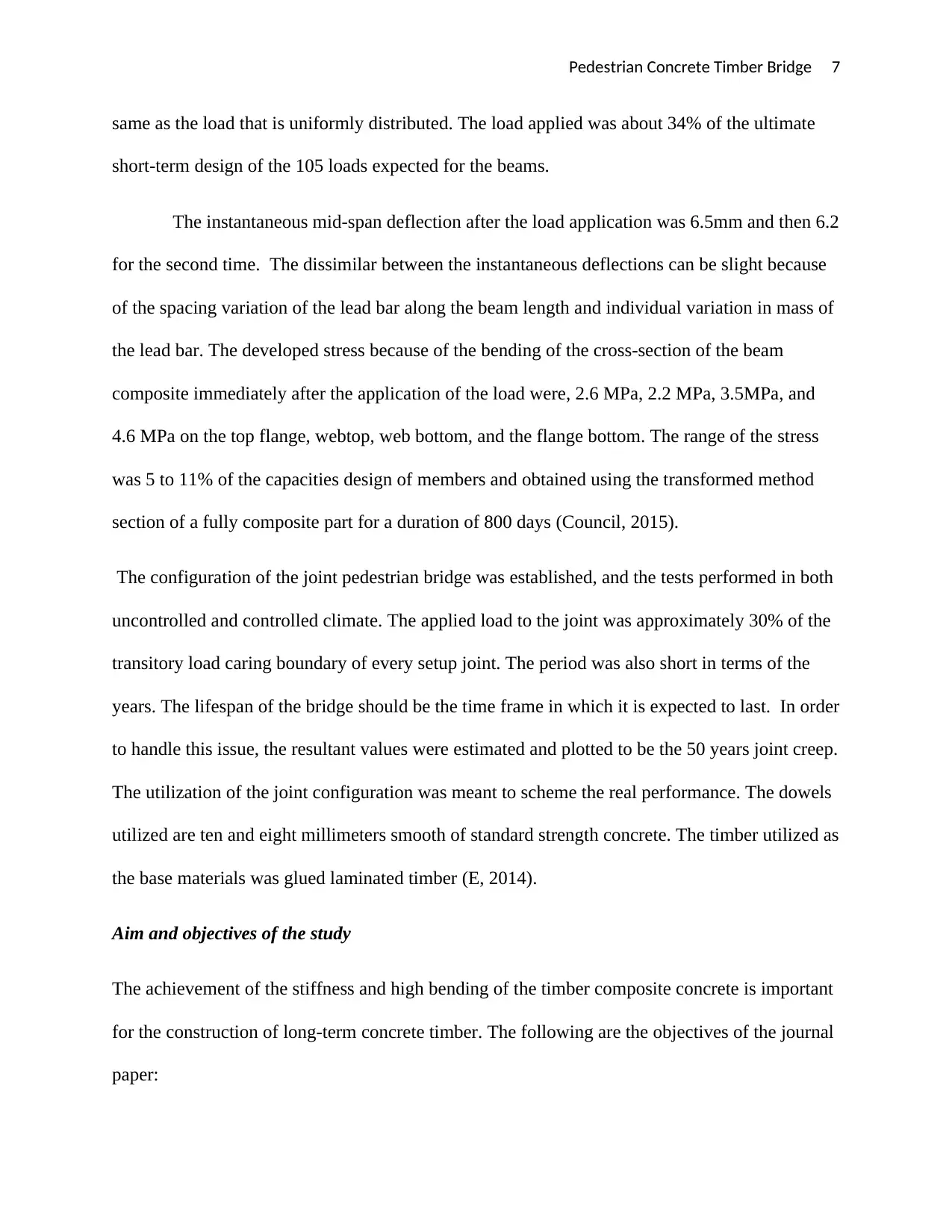
Pedestrian Concrete Timber Bridge 7
same as the load that is uniformly distributed. The load applied was about 34% of the ultimate
short-term design of the 105 loads expected for the beams.
The instantaneous mid-span deflection after the load application was 6.5mm and then 6.2
for the second time. The dissimilar between the instantaneous deflections can be slight because
of the spacing variation of the lead bar along the beam length and individual variation in mass of
the lead bar. The developed stress because of the bending of the cross-section of the beam
composite immediately after the application of the load were, 2.6 MPa, 2.2 MPa, 3.5MPa, and
4.6 MPa on the top flange, webtop, web bottom, and the flange bottom. The range of the stress
was 5 to 11% of the capacities design of members and obtained using the transformed method
section of a fully composite part for a duration of 800 days (Council, 2015).
The configuration of the joint pedestrian bridge was established, and the tests performed in both
uncontrolled and controlled climate. The applied load to the joint was approximately 30% of the
transitory load caring boundary of every setup joint. The period was also short in terms of the
years. The lifespan of the bridge should be the time frame in which it is expected to last. In order
to handle this issue, the resultant values were estimated and plotted to be the 50 years joint creep.
The utilization of the joint configuration was meant to scheme the real performance. The dowels
utilized are ten and eight millimeters smooth of standard strength concrete. The timber utilized as
the base materials was glued laminated timber (E, 2014).
Aim and objectives of the study
The achievement of the stiffness and high bending of the timber composite concrete is important
for the construction of long-term concrete timber. The following are the objectives of the journal
paper:
same as the load that is uniformly distributed. The load applied was about 34% of the ultimate
short-term design of the 105 loads expected for the beams.
The instantaneous mid-span deflection after the load application was 6.5mm and then 6.2
for the second time. The dissimilar between the instantaneous deflections can be slight because
of the spacing variation of the lead bar along the beam length and individual variation in mass of
the lead bar. The developed stress because of the bending of the cross-section of the beam
composite immediately after the application of the load were, 2.6 MPa, 2.2 MPa, 3.5MPa, and
4.6 MPa on the top flange, webtop, web bottom, and the flange bottom. The range of the stress
was 5 to 11% of the capacities design of members and obtained using the transformed method
section of a fully composite part for a duration of 800 days (Council, 2015).
The configuration of the joint pedestrian bridge was established, and the tests performed in both
uncontrolled and controlled climate. The applied load to the joint was approximately 30% of the
transitory load caring boundary of every setup joint. The period was also short in terms of the
years. The lifespan of the bridge should be the time frame in which it is expected to last. In order
to handle this issue, the resultant values were estimated and plotted to be the 50 years joint creep.
The utilization of the joint configuration was meant to scheme the real performance. The dowels
utilized are ten and eight millimeters smooth of standard strength concrete. The timber utilized as
the base materials was glued laminated timber (E, 2014).
Aim and objectives of the study
The achievement of the stiffness and high bending of the timber composite concrete is important
for the construction of long-term concrete timber. The following are the objectives of the journal
paper:
Paraphrase This Document
Need a fresh take? Get an instant paraphrase of this document with our AI Paraphraser
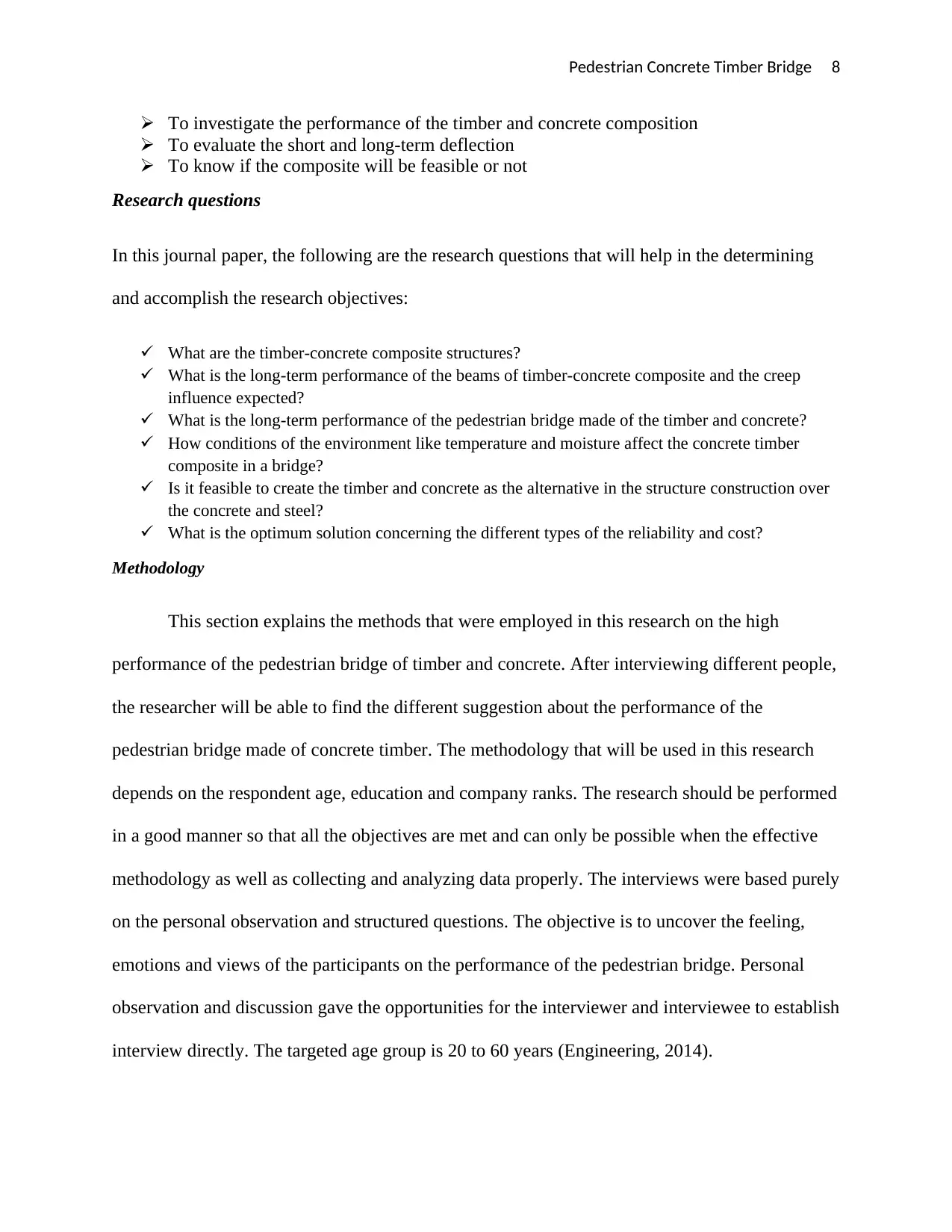
Pedestrian Concrete Timber Bridge 8
To investigate the performance of the timber and concrete composition
To evaluate the short and long-term deflection
To know if the composite will be feasible or not
Research questions
In this journal paper, the following are the research questions that will help in the determining
and accomplish the research objectives:
What are the timber-concrete composite structures?
What is the long-term performance of the beams of timber-concrete composite and the creep
influence expected?
What is the long-term performance of the pedestrian bridge made of the timber and concrete?
How conditions of the environment like temperature and moisture affect the concrete timber
composite in a bridge?
Is it feasible to create the timber and concrete as the alternative in the structure construction over
the concrete and steel?
What is the optimum solution concerning the different types of the reliability and cost?
Methodology
This section explains the methods that were employed in this research on the high
performance of the pedestrian bridge of timber and concrete. After interviewing different people,
the researcher will be able to find the different suggestion about the performance of the
pedestrian bridge made of concrete timber. The methodology that will be used in this research
depends on the respondent age, education and company ranks. The research should be performed
in a good manner so that all the objectives are met and can only be possible when the effective
methodology as well as collecting and analyzing data properly. The interviews were based purely
on the personal observation and structured questions. The objective is to uncover the feeling,
emotions and views of the participants on the performance of the pedestrian bridge. Personal
observation and discussion gave the opportunities for the interviewer and interviewee to establish
interview directly. The targeted age group is 20 to 60 years (Engineering, 2014).
To investigate the performance of the timber and concrete composition
To evaluate the short and long-term deflection
To know if the composite will be feasible or not
Research questions
In this journal paper, the following are the research questions that will help in the determining
and accomplish the research objectives:
What are the timber-concrete composite structures?
What is the long-term performance of the beams of timber-concrete composite and the creep
influence expected?
What is the long-term performance of the pedestrian bridge made of the timber and concrete?
How conditions of the environment like temperature and moisture affect the concrete timber
composite in a bridge?
Is it feasible to create the timber and concrete as the alternative in the structure construction over
the concrete and steel?
What is the optimum solution concerning the different types of the reliability and cost?
Methodology
This section explains the methods that were employed in this research on the high
performance of the pedestrian bridge of timber and concrete. After interviewing different people,
the researcher will be able to find the different suggestion about the performance of the
pedestrian bridge made of concrete timber. The methodology that will be used in this research
depends on the respondent age, education and company ranks. The research should be performed
in a good manner so that all the objectives are met and can only be possible when the effective
methodology as well as collecting and analyzing data properly. The interviews were based purely
on the personal observation and structured questions. The objective is to uncover the feeling,
emotions and views of the participants on the performance of the pedestrian bridge. Personal
observation and discussion gave the opportunities for the interviewer and interviewee to establish
interview directly. The targeted age group is 20 to 60 years (Engineering, 2014).
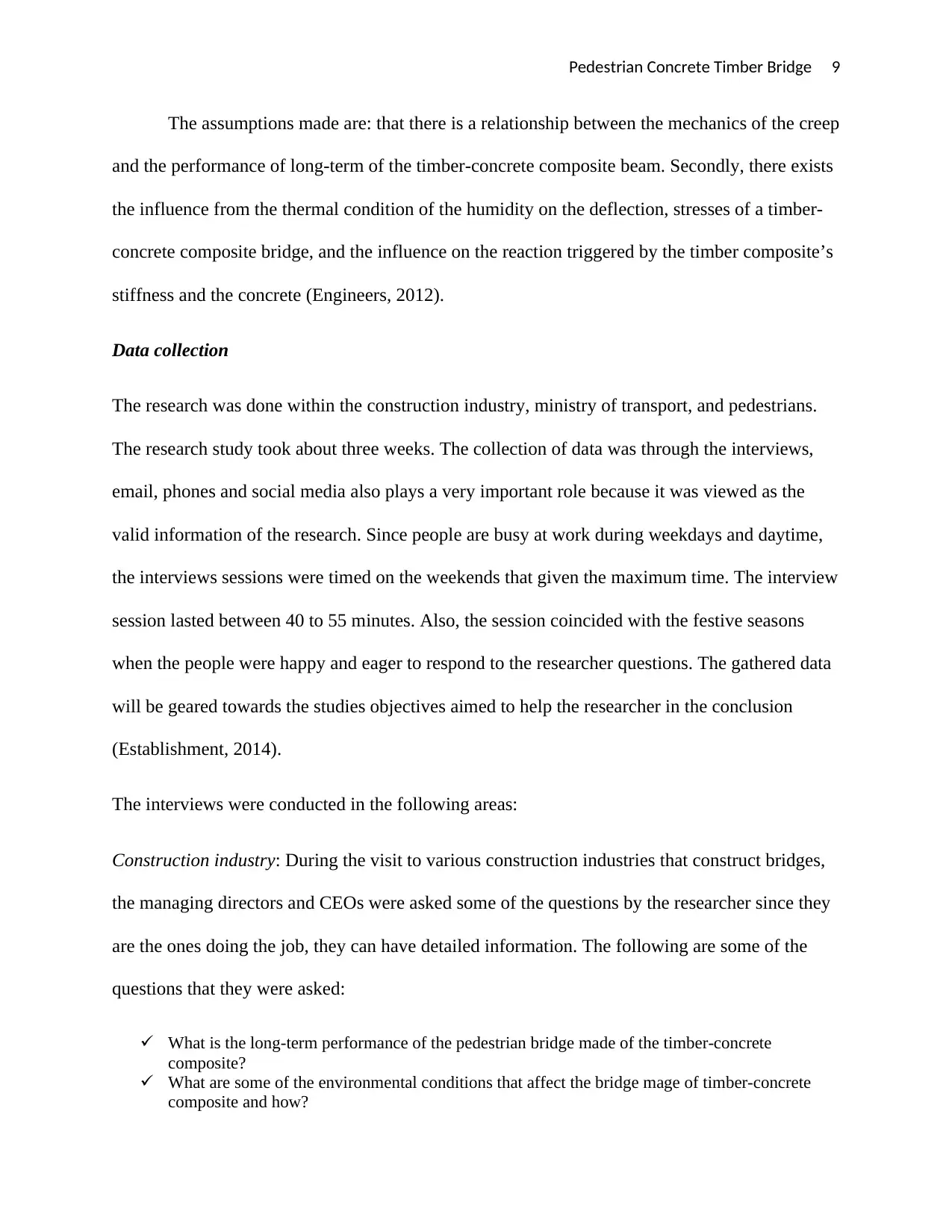
Pedestrian Concrete Timber Bridge 9
The assumptions made are: that there is a relationship between the mechanics of the creep
and the performance of long-term of the timber-concrete composite beam. Secondly, there exists
the influence from the thermal condition of the humidity on the deflection, stresses of a timber-
concrete composite bridge, and the influence on the reaction triggered by the timber composite’s
stiffness and the concrete (Engineers, 2012).
Data collection
The research was done within the construction industry, ministry of transport, and pedestrians.
The research study took about three weeks. The collection of data was through the interviews,
email, phones and social media also plays a very important role because it was viewed as the
valid information of the research. Since people are busy at work during weekdays and daytime,
the interviews sessions were timed on the weekends that given the maximum time. The interview
session lasted between 40 to 55 minutes. Also, the session coincided with the festive seasons
when the people were happy and eager to respond to the researcher questions. The gathered data
will be geared towards the studies objectives aimed to help the researcher in the conclusion
(Establishment, 2014).
The interviews were conducted in the following areas:
Construction industry: During the visit to various construction industries that construct bridges,
the managing directors and CEOs were asked some of the questions by the researcher since they
are the ones doing the job, they can have detailed information. The following are some of the
questions that they were asked:
What is the long-term performance of the pedestrian bridge made of the timber-concrete
composite?
What are some of the environmental conditions that affect the bridge mage of timber-concrete
composite and how?
The assumptions made are: that there is a relationship between the mechanics of the creep
and the performance of long-term of the timber-concrete composite beam. Secondly, there exists
the influence from the thermal condition of the humidity on the deflection, stresses of a timber-
concrete composite bridge, and the influence on the reaction triggered by the timber composite’s
stiffness and the concrete (Engineers, 2012).
Data collection
The research was done within the construction industry, ministry of transport, and pedestrians.
The research study took about three weeks. The collection of data was through the interviews,
email, phones and social media also plays a very important role because it was viewed as the
valid information of the research. Since people are busy at work during weekdays and daytime,
the interviews sessions were timed on the weekends that given the maximum time. The interview
session lasted between 40 to 55 minutes. Also, the session coincided with the festive seasons
when the people were happy and eager to respond to the researcher questions. The gathered data
will be geared towards the studies objectives aimed to help the researcher in the conclusion
(Establishment, 2014).
The interviews were conducted in the following areas:
Construction industry: During the visit to various construction industries that construct bridges,
the managing directors and CEOs were asked some of the questions by the researcher since they
are the ones doing the job, they can have detailed information. The following are some of the
questions that they were asked:
What is the long-term performance of the pedestrian bridge made of the timber-concrete
composite?
What are some of the environmental conditions that affect the bridge mage of timber-concrete
composite and how?
⊘ This is a preview!⊘
Do you want full access?
Subscribe today to unlock all pages.

Trusted by 1+ million students worldwide
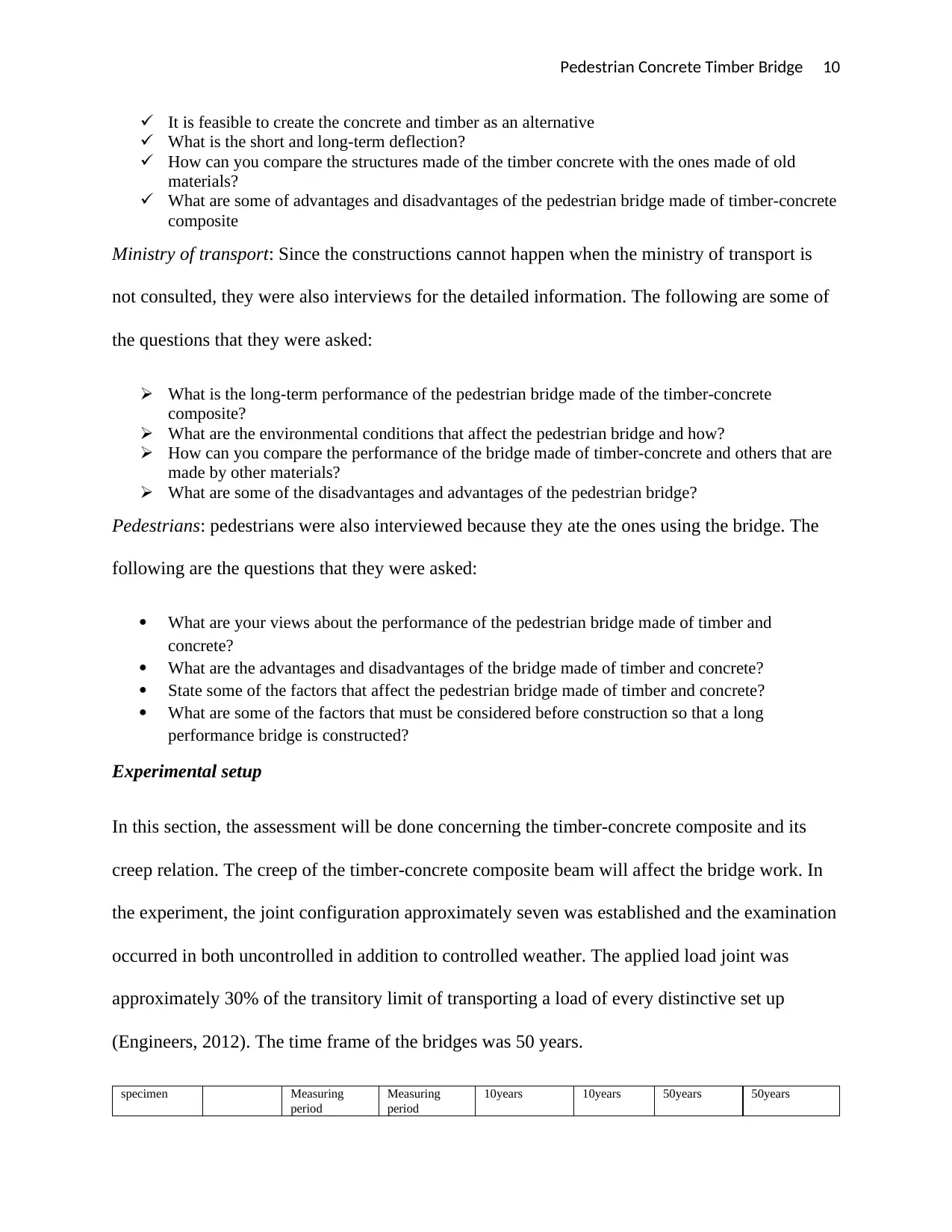
Pedestrian Concrete Timber Bridge 10
It is feasible to create the concrete and timber as an alternative
What is the short and long-term deflection?
How can you compare the structures made of the timber concrete with the ones made of old
materials?
What are some of advantages and disadvantages of the pedestrian bridge made of timber-concrete
composite
Ministry of transport: Since the constructions cannot happen when the ministry of transport is
not consulted, they were also interviews for the detailed information. The following are some of
the questions that they were asked:
What is the long-term performance of the pedestrian bridge made of the timber-concrete
composite?
What are the environmental conditions that affect the pedestrian bridge and how?
How can you compare the performance of the bridge made of timber-concrete and others that are
made by other materials?
What are some of the disadvantages and advantages of the pedestrian bridge?
Pedestrians: pedestrians were also interviewed because they ate the ones using the bridge. The
following are the questions that they were asked:
What are your views about the performance of the pedestrian bridge made of timber and
concrete?
What are the advantages and disadvantages of the bridge made of timber and concrete?
State some of the factors that affect the pedestrian bridge made of timber and concrete?
What are some of the factors that must be considered before construction so that a long
performance bridge is constructed?
Experimental setup
In this section, the assessment will be done concerning the timber-concrete composite and its
creep relation. The creep of the timber-concrete composite beam will affect the bridge work. In
the experiment, the joint configuration approximately seven was established and the examination
occurred in both uncontrolled in addition to controlled weather. The applied load joint was
approximately 30% of the transitory limit of transporting a load of every distinctive set up
(Engineers, 2012). The time frame of the bridges was 50 years.
specimen Measuring
period
Measuring
period
10years 10years 50years 50years
It is feasible to create the concrete and timber as an alternative
What is the short and long-term deflection?
How can you compare the structures made of the timber concrete with the ones made of old
materials?
What are some of advantages and disadvantages of the pedestrian bridge made of timber-concrete
composite
Ministry of transport: Since the constructions cannot happen when the ministry of transport is
not consulted, they were also interviews for the detailed information. The following are some of
the questions that they were asked:
What is the long-term performance of the pedestrian bridge made of the timber-concrete
composite?
What are the environmental conditions that affect the pedestrian bridge and how?
How can you compare the performance of the bridge made of timber-concrete and others that are
made by other materials?
What are some of the disadvantages and advantages of the pedestrian bridge?
Pedestrians: pedestrians were also interviewed because they ate the ones using the bridge. The
following are the questions that they were asked:
What are your views about the performance of the pedestrian bridge made of timber and
concrete?
What are the advantages and disadvantages of the bridge made of timber and concrete?
State some of the factors that affect the pedestrian bridge made of timber and concrete?
What are some of the factors that must be considered before construction so that a long
performance bridge is constructed?
Experimental setup
In this section, the assessment will be done concerning the timber-concrete composite and its
creep relation. The creep of the timber-concrete composite beam will affect the bridge work. In
the experiment, the joint configuration approximately seven was established and the examination
occurred in both uncontrolled in addition to controlled weather. The applied load joint was
approximately 30% of the transitory limit of transporting a load of every distinctive set up
(Engineers, 2012). The time frame of the bridges was 50 years.
specimen Measuring
period
Measuring
period
10years 10years 50years 50years
Paraphrase This Document
Need a fresh take? Get an instant paraphrase of this document with our AI Paraphraser
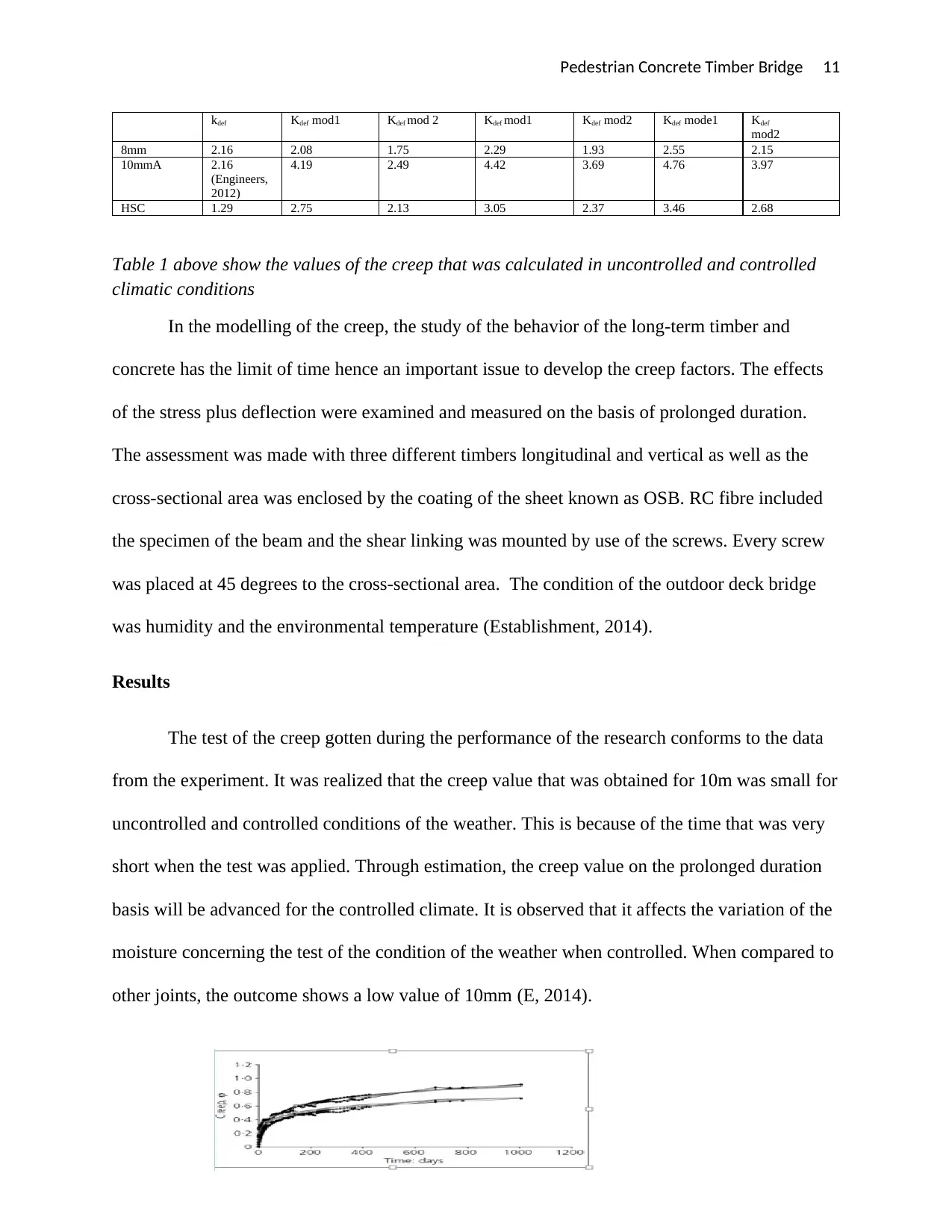
Pedestrian Concrete Timber Bridge 11
kdef Kdef mod1 Kdef mod 2 Kdef mod1 Kdef mod2 Kdef mode1 Kdef
mod2
8mm 2.16 2.08 1.75 2.29 1.93 2.55 2.15
10mmA 2.16
(Engineers,
2012)
4.19 2.49 4.42 3.69 4.76 3.97
HSC 1.29 2.75 2.13 3.05 2.37 3.46 2.68
Table 1 above show the values of the creep that was calculated in uncontrolled and controlled
climatic conditions
In the modelling of the creep, the study of the behavior of the long-term timber and
concrete has the limit of time hence an important issue to develop the creep factors. The effects
of the stress plus deflection were examined and measured on the basis of prolonged duration.
The assessment was made with three different timbers longitudinal and vertical as well as the
cross-sectional area was enclosed by the coating of the sheet known as OSB. RC fibre included
the specimen of the beam and the shear linking was mounted by use of the screws. Every screw
was placed at 45 degrees to the cross-sectional area. The condition of the outdoor deck bridge
was humidity and the environmental temperature (Establishment, 2014).
Results
The test of the creep gotten during the performance of the research conforms to the data
from the experiment. It was realized that the creep value that was obtained for 10m was small for
uncontrolled and controlled conditions of the weather. This is because of the time that was very
short when the test was applied. Through estimation, the creep value on the prolonged duration
basis will be advanced for the controlled climate. It is observed that it affects the variation of the
moisture concerning the test of the condition of the weather when controlled. When compared to
other joints, the outcome shows a low value of 10mm (E, 2014).
kdef Kdef mod1 Kdef mod 2 Kdef mod1 Kdef mod2 Kdef mode1 Kdef
mod2
8mm 2.16 2.08 1.75 2.29 1.93 2.55 2.15
10mmA 2.16
(Engineers,
2012)
4.19 2.49 4.42 3.69 4.76 3.97
HSC 1.29 2.75 2.13 3.05 2.37 3.46 2.68
Table 1 above show the values of the creep that was calculated in uncontrolled and controlled
climatic conditions
In the modelling of the creep, the study of the behavior of the long-term timber and
concrete has the limit of time hence an important issue to develop the creep factors. The effects
of the stress plus deflection were examined and measured on the basis of prolonged duration.
The assessment was made with three different timbers longitudinal and vertical as well as the
cross-sectional area was enclosed by the coating of the sheet known as OSB. RC fibre included
the specimen of the beam and the shear linking was mounted by use of the screws. Every screw
was placed at 45 degrees to the cross-sectional area. The condition of the outdoor deck bridge
was humidity and the environmental temperature (Establishment, 2014).
Results
The test of the creep gotten during the performance of the research conforms to the data
from the experiment. It was realized that the creep value that was obtained for 10m was small for
uncontrolled and controlled conditions of the weather. This is because of the time that was very
short when the test was applied. Through estimation, the creep value on the prolonged duration
basis will be advanced for the controlled climate. It is observed that it affects the variation of the
moisture concerning the test of the condition of the weather when controlled. When compared to
other joints, the outcome shows a low value of 10mm (E, 2014).
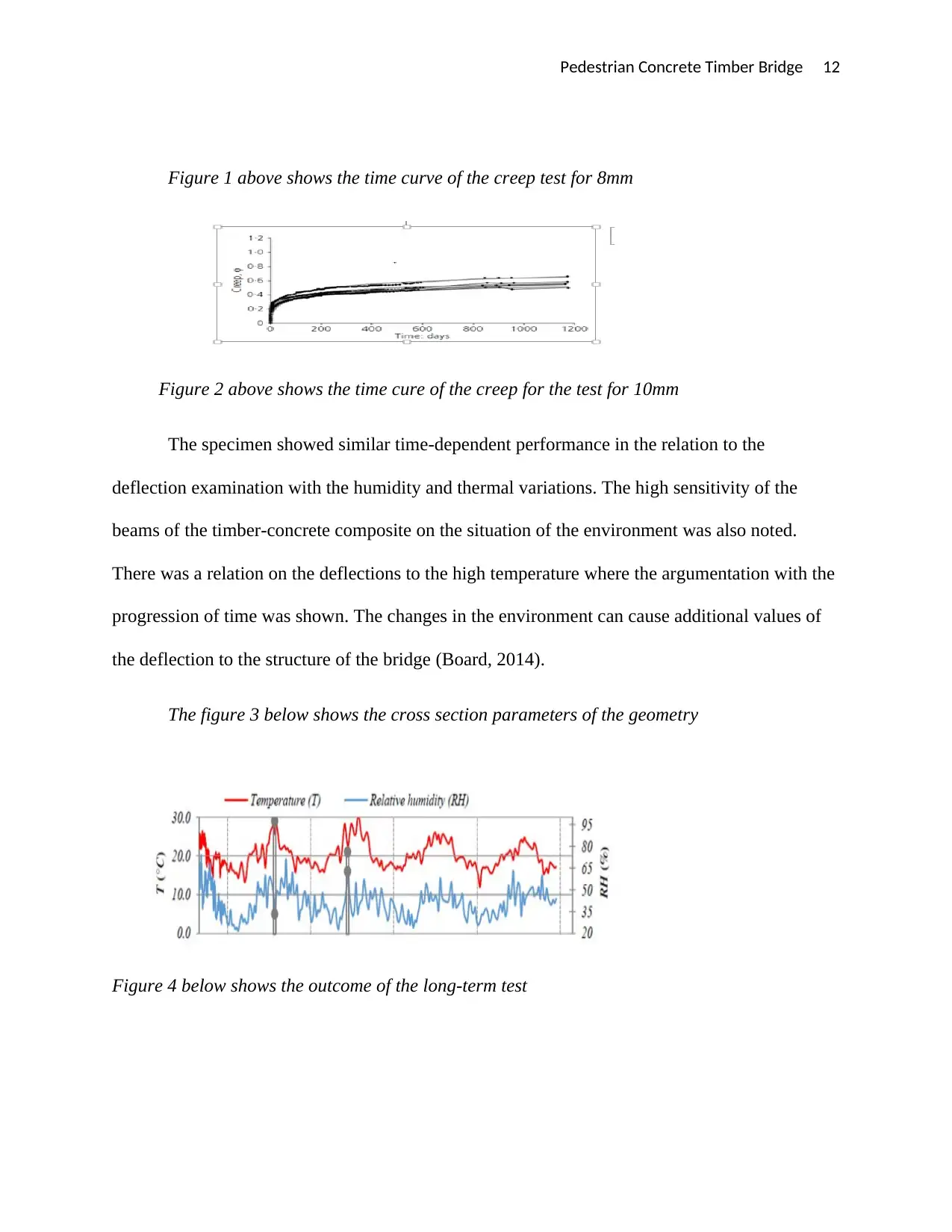
Pedestrian Concrete Timber Bridge 12
Figure 1 above shows the time curve of the creep test for 8mm
Figure 2 above shows the time cure of the creep for the test for 10mm
The specimen showed similar time-dependent performance in the relation to the
deflection examination with the humidity and thermal variations. The high sensitivity of the
beams of the timber-concrete composite on the situation of the environment was also noted.
There was a relation on the deflections to the high temperature where the argumentation with the
progression of time was shown. The changes in the environment can cause additional values of
the deflection to the structure of the bridge (Board, 2014).
The figure 3 below shows the cross section parameters of the geometry
Figure 4 below shows the outcome of the long-term test
Figure 1 above shows the time curve of the creep test for 8mm
Figure 2 above shows the time cure of the creep for the test for 10mm
The specimen showed similar time-dependent performance in the relation to the
deflection examination with the humidity and thermal variations. The high sensitivity of the
beams of the timber-concrete composite on the situation of the environment was also noted.
There was a relation on the deflections to the high temperature where the argumentation with the
progression of time was shown. The changes in the environment can cause additional values of
the deflection to the structure of the bridge (Board, 2014).
The figure 3 below shows the cross section parameters of the geometry
Figure 4 below shows the outcome of the long-term test
⊘ This is a preview!⊘
Do you want full access?
Subscribe today to unlock all pages.

Trusted by 1+ million students worldwide
1 out of 18
Related Documents
Your All-in-One AI-Powered Toolkit for Academic Success.
+13062052269
info@desklib.com
Available 24*7 on WhatsApp / Email
![[object Object]](/_next/static/media/star-bottom.7253800d.svg)
Unlock your academic potential
Copyright © 2020–2025 A2Z Services. All Rights Reserved. Developed and managed by ZUCOL.





